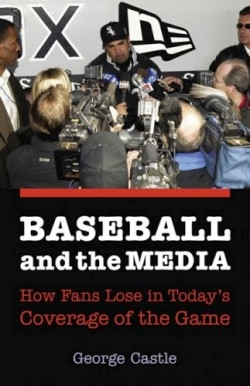Baseball and the Media
How Fans Lose in Today's Coverage of the Game
The days of an Oscar Madison-type sportswriter schlepping around a battered portable typewriter while covering the New York Mets are over. Today’s reporters have to contend with grueling schedules, crushing deadlines, shrinking newspaper budgets, and competition from other sources that make their jobs difficult. All of this comes at the expense of the true baseball fan, who is caught in the middle.
The author, a Chicago-area journalist who has covered both the Cubs and the White Sox, writes anecdotally on trends over the last thirty years or so. This is not a scholarly treatise; he quotes from other sportswriters, team media directors, and athletes, rather than academic statistics, which helps the average reader relate.
Each generation seems to add a new twist when it comes to covering the national pastime. First it was radio, encroaching upon territory that was once the exclusive property of newspapers, but bringing the game to fans in faraway places that would otherwise never have the opportunity to “attend” a live game. Then came television, nosing radio aside and putting a scare into owners who thought it would keep fans from coming out to the ballpark.
Now, it’s the Internet, which Castle blames for making the scramble for breaking news more important than accuracy. The relatively recent phenomenon of “sports talk radio” is even worse. It’s entertainment, says Castle, and therefore not to be judged by higher journalistic standards.
In the 1970s, several ball clubs built stadiums that were practically interchangeable; “cookie-cutters” was the derisive description. The same could be applied to today’s broadcasters. Castle bemoans the dearth of personalities such as Harry Caray and Jack Brickhouse, replaced by interchangeable drones and ex-jock color commentators. Despite all the glitz, Castle maintains, the industry has become more sizzle and less steak.
He also offers the players’ point of view. Bombarded with the same series of questions day after day—or having their every flaw magnified by those pesky sports talk hosts—is it any wonder they have a difficult time putting on a happy face? The same attitude extends to newspaper columnists (as opposed to beat writers who are constantly around the team), with whom they rarely speak.
His most interesting analysis comes when he compares the media coverage from the New York/Los Angeles media hotbeds with those of smaller markets that literally can’t afford to devote as much time, personnel, and ink to baseball coverage, relying instead on wire service copy to fill space.
There’s something to be said for the nostalgic simplicity of an organ at the ballpark, rather than the constant blare of the deafening rock music most teams assault their patrons with. Castle speaks on behalf of the purist fans who yearn for those days.
Reviewed by
Ron Kaplan
Disclosure: This article is not an endorsement, but a review. The publisher of this book provided free copies of the book to have their book reviewed by a professional reviewer. No fee was paid by the publisher for this review. Foreword Reviews only recommends books that we love. Foreword Magazine, Inc. is disclosing this in accordance with the Federal Trade Commission’s 16 CFR, Part 255.

